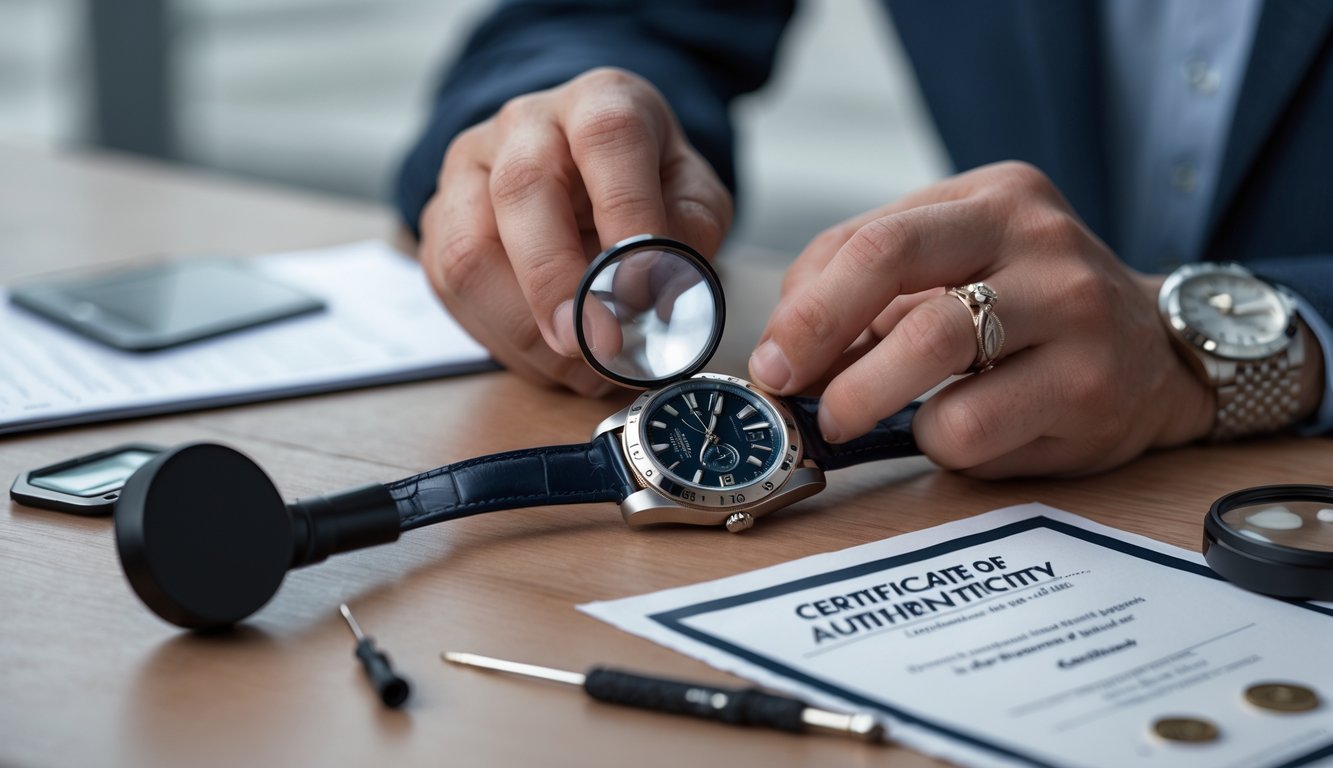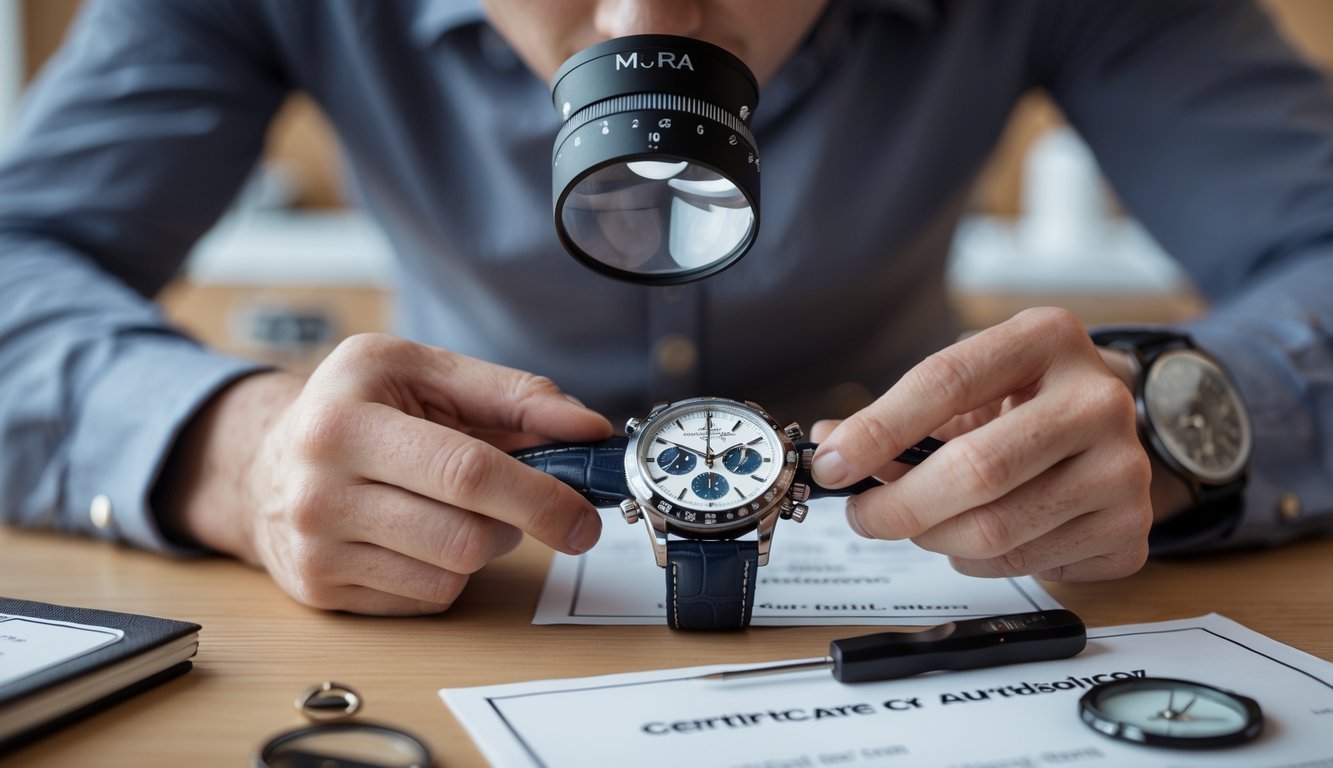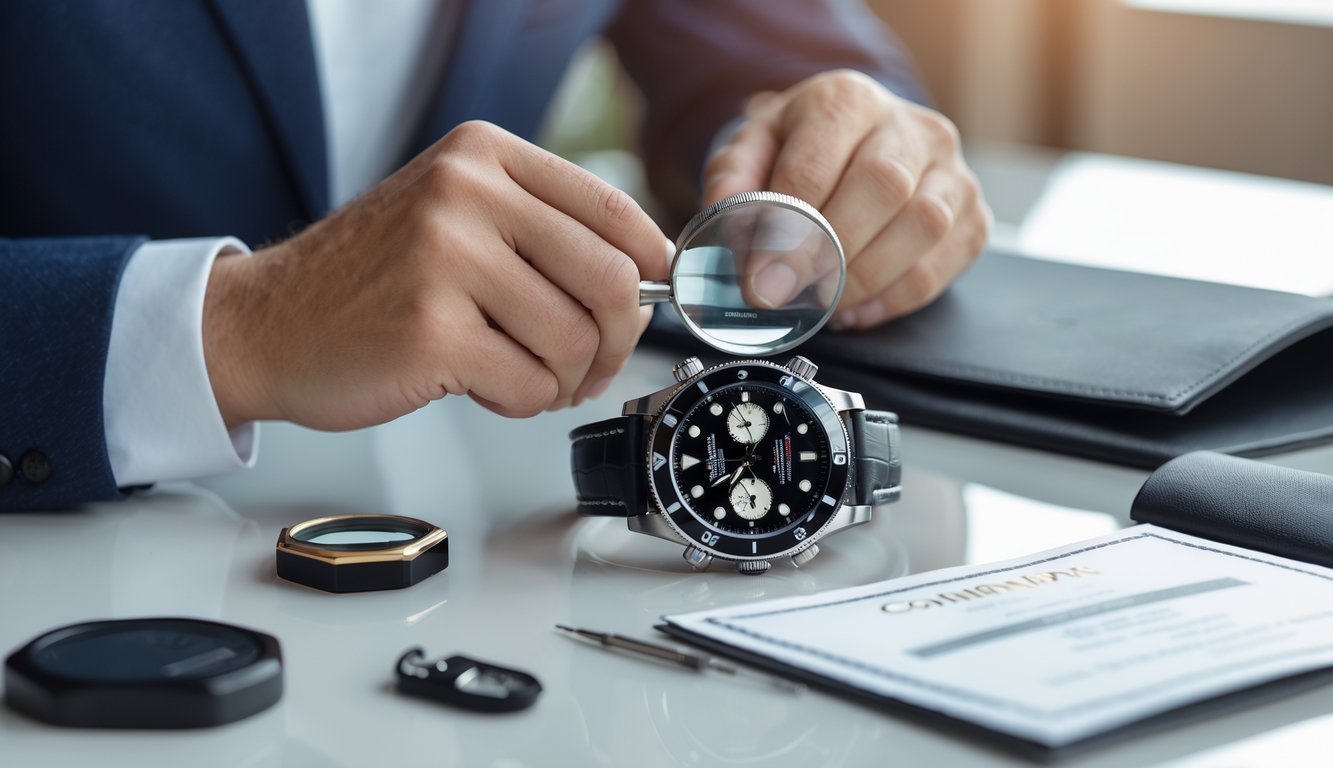Fake watches are everywhere these days, making it tricky to spot real luxury timepieces among all the convincing fakes. You can verify a watch’s authenticity by checking serial numbers, looking at movement quality, and comparing details with the brand’s official specs. Every year, buyers lose thousands of dollars to counterfeits that look almost identical to the real thing.
Learning to spot authentic watches helps protect your investment and makes sure you get what you pay for.
The differences between real and fake watches usually hide in tiny details most folks overlook.
Weight, engravings, and even the sound of the movement can tell you a lot about where a watch really came from.
This guide lays out the steps experts use to authenticate luxury watches.
You’ll find out what red flags to look for and how to use official resources to check your timepiece.
With these tips, you can buy and sell watches with a lot more confidence.
Key Takeaways
- Real watches have serial numbers and engravings that match up with manufacturer databases
- Movement quality and little craftsmanship details help show if a watch is real or fake
- Getting a professional opinion or checking with an official dealer is the most reliable way to confirm authenticity
Key Steps to Authenticate a Watch

Counterfeiters have a hard time copying certain features of authentic watches perfectly.
The best ways to check a watch focus on serial numbers, material quality, and the movement inside.
Examine Serial Numbers and Logos
Start by checking where the serial number sits.
Real luxury watches engrave serial numbers in specific spots, and it varies by brand.
Rolex puts serial numbers between the lugs at 6 o’clock.
Omega uses the case back or between the lugs.
Patek Philippe engraves them on the case back.
Serial Number Quality:
- Deep, clear engraving with even depth
- Sharp numbers with no rough edges
- Proper font that matches the brand’s style
- No smudging or weird spacing
Take a close look at the logo.
Authentic logos have perfect symmetry and sharp details.
Look for these logo details:
- Crown logos: Should have the right proportions and clean lines
- Text spacing: Letters are spaced evenly
- Font weight: Matches the brand’s official font
- Alignment: Logos are perfectly centered
Fake watches often have logos that look a bit off or blurry.
Compare your watch’s logo to official brand photos online.
Inspect Materials and Craftsmanship
Feel the weight of the watch.
Real luxury watches use solid metals, so they feel heavy.
Gold and platinum watches feel a lot heavier than steel.
Fakes usually use light alloys that just feel cheap or hollow.
Material Quality Checks:
- Case finishing: Should be smooth with even brushing or polishing
- Bracelet links: Tight connections, no gaps
- Clasp mechanism: Works smoothly and feels solid
- Crystal clarity: Sapphire crystal is super clear and doesn’t scratch easily
Check the dial up close.
Authentic watches have markers and hands that are applied perfectly.
Look for these craftsmanship signs:
- Hour markers sit flush and straight
- Hands line up with the markers
- Date windows are centered
- Text looks crisp and clean
Run your finger along the case edges.
Real watches have smooth, rounded edges, not sharp or rough spots.
Evaluate Movement and Internal Components
If you can, open the case back.
Authentic movements have intricate details and quality finishing.
Swiss movements often show Geneva stripes or perlage.
Japanese movements usually look clean and functional.
Movement Authentication:
- Rotor decoration: Brand engravings and proper finishing
- Jewel count: Matches the model’s specs
- Component layout: Looks like official movement photos
- Oscillation rate: Has the right beats per hour
Listen to the ticking.
Mechanical watches tick steadily and rhythmically.
Quartz watches tick once per second, very precisely.
Try the crown.
Real watches wind and set the time smoothly.
The crown should:
- Pull out to set positions
- Wind without grinding
- Snap back into place easily
- Feel sturdy, not loose
Watch the second hand move.
Good quartz movements jump exactly to each marker.
Mechanical ones might have a little trembling.
Expert Guidance and Additional Resources

Getting professional help or using the right tools can save you from buying a fake.
Good documentation and warranty checks also protect your investment.
Consult Authorized Dealers or Watchmakers
Visit authorized dealers for your watch brand first.
They know all the details about real models and can spot fakes fast.
Authorized dealers use official databases to verify serial numbers and check production records right away.
Find certified watchmakers nearby who work with luxury watches.
Look for folks with brand-specific training or certificates.
These experts check the movement, case, and inside components.
They have special tools you probably don’t have at home.
Ask about authentication services before you go.
Many dealers offer this for a small fee, even if you bought the watch elsewhere.
Some watchmakers give you a written authentication certificate.
That’s handy if you want to sell the watch later.
Use Online Verification Tools
Check the brand’s official website for serial number tools.
Lots of luxury brands now let you check serial numbers online.
Type in your watch’s serial number and model info.
The system will tell you if those numbers match a real watch.
Use brand-specific mobile apps if they’re available.
Rolex, Omega, and others have apps for checking watches on your phone.
These apps sometimes include features like warranty tracking or service history.
Only download them from official app stores.
Avoid third-party verification sites that charge fees.
Stick with official brand resources for the most accurate info.
Some brands ask you to make an account first.
It’s a small hassle, but it helps keep their databases secure.
Understand Warranty and Documentation
Real watches come with official warranty cards that have specific info.
Look for proper stamps, signatures, and the right date format.
The warranty card should match your watch’s serial number exactly.
If there’s a mismatch, that’s a red flag.
Original packaging helps with verification too.
Genuine boxes, booklets, and certificates have high quality and proper branding.
Check for good printing, no spelling mistakes, and clear images.
Fake documents usually have obvious errors.
Service records help prove authenticity. Authorized service centers keep detailed records of repairs and maintenance.
Contact the brand’s customer service to check your watch’s service history.
They’ll let you know if any work was done by their technicians.
Keep all documents safe in a secure place.
These papers help prove your watch is real and keep its resale value up.
Frequently Asked Questions

Checking if a watch is real means looking at physical features, serial numbers, and paperwork.
You can do most checks at home, but professional authentication gives you the most reliable answer.
What steps should I take to verify the authenticity of a luxury watch?
Start by feeling the watch’s weight in your hand.
Authentic luxury watches use high-quality materials and feel solid and smooth.
Check the logo and brand markings for sharpness and correct alignment.
Real watches have crisp, perfectly lined up text and logos, with no spelling mistakes.
Look at the movement through the case back if you can.
Luxury watches usually show detailed, well-finished movements with the right brand markings.
Test all the functions—crown, pushers, any extras.
Real watches work smoothly and don’t stick or feel rough.
Is there a reliable method to check a watch’s authenticity using its serial number?
Contact the brand directly with the serial number.
Most luxury brands keep databases and can check authenticity that way.
Look up the serial number on the brand’s official website.
Many have online tools for this.
Cross-check the serial number with the model and production year.
Each brand uses specific formats and ranges for serial numbers.
Just remember—some fakes use real serial numbers copied from genuine watches.
Serial number checks work best when you also inspect the watch in person.
Can I perform an authenticity check on a watch through online services for free?
Some websites offer basic photo comparison tools.
They’ll show your watch photos next to real ones from their database.
Use the manufacturer’s website for detailed specs and clear photos.
You can compare your watch with official images and details.
Visit online forums and communities where experienced collectors share advice.
These places are full of helpful tips from people who know their stuff.
But free online services have limits.
They can’t replace a professional check for expensive purchases or insurance.
What are common indicators of a counterfeit watch compared to a genuine one?
Cheap materials stand out in fake watches.
They feel light, have rough edges, or come with flimsy straps and bracelets.
Spelling mistakes and misaligned text show up a lot on fakes.
Check all the writing on the dial, case back, and clasp for errors and crooked letters.
Wrong or missing serial numbers are a big warning sign.
Fakes often have bad engravings or no serial numbers at all.
If you find a quartz movement in a watch that’s supposed to be mechanical, that’s a giveaway.
Many fake luxury watches use cheap quartz instead of proper mechanical movements.
How can I authenticate a watch if I don’t have access to its original paperwork?
Focus on the watch itself.
Look at the case, dial, and movement details—these are tough for counterfeiters to copy well.
Search for your specific model online using the reference number.
Compare your watch with official specs and real examples from trusted dealers.
Have a certified watchmaker or authorized dealer take a look.
They can spot authenticity markers you might miss.
If you want, use a third-party authentication service that specializes in luxury watches.
They can give you a detailed report, even without the original paperwork.
What resources are available for confirming the authenticity of designer watch brands?
If you want the most reliable authentication, go straight to authorized dealers.
You can stop by official brand boutiques or ask certified retailers—they know their stuff and can check your watch professionally.
Many brands run their own online databases with technical specs.
You’ll usually find these on the luxury watch company’s website, where they’ve posted model details and serial number guides.
Some companies focus entirely on authenticating luxury watches.
They do charge for their services, but they’ll give you a detailed report you can use for insurance or if you’re thinking about selling.
You’ll also find a lot of knowledge in watchmaking forums and collector groups.
Experienced collectors like to share tips and talk about how to spot fakes for different brands.


